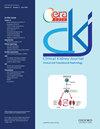Cerebral white matter injury in hemodialysis patients: a cross-sectional tract-based spatial statistics and fixel-based analysis
IF 3.9
2区 医学
Q1 UROLOGY & NEPHROLOGY
引用次数: 0
Abstract
Background End-stage renal disease (ESRD) patients with maintenance hemodialysis (HD) are often accompanied by damage to brain white matter (WM) and cognitive impairment. However, whether this damage is caused by maintenance HD or renal dysfunction is unclear. Purpose To investigate the natural progression of WM damage in patients with ESRD and the effects of HD on WM using Tract-based spatial statistics (TBSS) and fixel-based analysis (FBA). Population Eighty-one ESRD patients including 41 with no dialysis (ND) and 40 with HD and forty-six healthy controls (HCs) were enrolled in this study. Field Strength/Sequence A 3 T, single-shot spin–echo echo planar imaging (EPI). Assessment The difference of WM among the three groups (ESRD patients with HD, ESRD patients without HD and HCs) were analyzed using Tract-based spatial statistics (TBSS) and fixel-based analysis (FBA), pairwise comparison was then used to compare the difference of WM between two groups. Relationship between WM and neurocognitive assessments/clinical data were analyzed in ESRD patients with or without HD. Statistical Tests Group t-test, Chi-square Test, Kruskal–Wallis test, Mann–Whitney U-Test, Spearman’ correlation analysis, non-parametric permutation testing. Results The damage of WM in ESRD with ND and ESRD HD appeared around the lateral ventricles similarly used for TBSS while FBA reflected the changes had extended to adjacent WM in anterior hemisphere, with larger region in ESRD HD compared to ESRD ND and the brainstem was also widely affected in ESRD HD. The levels of MoCA score were lower in ESRD HD group. RD in body of corpus callosum (BCC) were negatively correlated with MoCA score in both groups. FDC in left Thalamo-prefrontal projection (T_PREFL), left and right cingulum (CGL and CGR) were positively correlated with MoCA score in both groups. Creatinine (Cr) was positively correlated with FDC in some frontal projection fibers in striatum and thalamus, CG and fronto-pontine tract (FPT), Cr was positively correlated with FD mainly in premotor projection fibers in striatum and thalamus in ESRD HD group. Cr was negatively correlated with MD and RD in regions of corona radiata ESRD ND group. Data Conclusion FBA is more sensitive in detecting differences between ESRD patients and HCs. When ESRD patients receive maintenance HD, the degree of WM damage may not be aggravated, however, the range of damaged WM can be expanded, especially in anterior hemisphere and brainstem, some of these changes in anterior hemisphere may contribute to cognitive decline.血液透析患者的脑白质损伤:基于横断面束的空间统计和定格分析
背景 接受维持性血液透析(HD)的终末期肾病(ESRD)患者通常伴有脑白质(WM)损伤和认知障碍。然而,这种损害是由维持性血液透析还是肾功能障碍引起的尚不清楚。目的 使用基于瓣膜的空间统计(TBSS)和基于固定颗粒的分析(FBA)研究 ESRD 患者脑白质损伤的自然进展以及 HD 对脑白质的影响。研究对象 本研究共纳入 81 名 ESRD 患者(包括 41 名未透析患者 (ND)、40 名 HD 患者和 46 名健康对照组 (HC))。场强/序列 3 T、单发自旋回波平面成像(EPI)。评估 采用ract-based spatial statistics (TBSS)和fixel-based analysis (FBA)分析三组(患有HD的ESRD患者、未患有HD的ESRD患者和HCs)之间的WM差异,然后采用配对比较法比较两组之间的WM差异。分析合并或未合并 HD 的 ESRD 患者的 WM 与神经认知评估/临床数据之间的关系。统计检验方法 组间 t 检验、卡方检验、曼-惠特尼 U 检验、斯皮尔曼相关分析、非参数置换检验。结果 ESRD合并ND和ESRD HD的WM损害出现在侧脑室周围,与TBSS相似,而FBA反映出其改变已扩展到前半球邻近的WM,ESRD HD比ESRD ND受影响的区域更大,ESRD HD的脑干也受到广泛影响。ESRD HD 组的 MoCA 评分水平较低。两组胼胝体(BCC)的RD均与MoCA评分呈负相关。两组患者左侧Thalamo-prefrontal投射(T_PREFL)、左右侧cingulum(CGL和CGR)的FDC均与MoCA评分呈正相关。肌酸酐(Cr)与纹状体和丘脑部分额叶投射纤维、CG和前脑束(FPT)的FDC呈正相关,Cr与FD呈正相关,ESRD HD组的FD主要存在于纹状体和丘脑的前运动投射纤维中。在 ESRD ND 组,Cr 与放射冠区域的 MD 和 RD 呈负相关。数据结论 FBA 在检测 ESRD 患者和 HC 之间的差异方面更为敏感。ESRD 患者在接受维持性 HD 治疗时,WM 的损伤程度可能不会加重,但 WM 受损的范围可能会扩大,尤其是前半球和脑干,前半球的某些变化可能会导致认知能力下降。
本文章由计算机程序翻译,如有差异,请以英文原文为准。
求助全文
约1分钟内获得全文
求助全文
来源期刊

Clinical Kidney Journal
Medicine-Transplantation
CiteScore
6.70
自引率
10.90%
发文量
242
审稿时长
8 weeks
期刊介绍:
About the Journal
Clinical Kidney Journal: Clinical and Translational Nephrology (ckj), an official journal of the ERA-EDTA (European Renal Association-European Dialysis and Transplant Association), is a fully open access, online only journal publishing bimonthly. The journal is an essential educational and training resource integrating clinical, translational and educational research into clinical practice. ckj aims to contribute to a translational research culture among nephrologists and kidney pathologists that helps close the gap between basic researchers and practicing clinicians and promote sorely needed innovation in the Nephrology field. All research articles in this journal have undergone peer review.
 求助内容:
求助内容: 应助结果提醒方式:
应助结果提醒方式:


